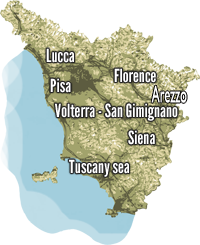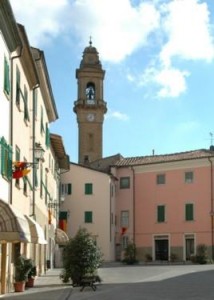historians consider Pomarance one of the oldest castles in the countryside of Volterra, the first documents found belong to the tenth century, although there are numerous archaeological remains dating from the Neolithic period.
The earliest Neolithic remains were found in countryside, Le Stoppiacce today The Farm I Reucci.
Under the Church of San Giovanni Battista in downtown Pomarance some Etruscan tombs have been found dating from the fifth century. BC
History tells us that the castle was given to the family of Pomarance Inghirami by Emperor Otto I in 962, was later a fief of the Bishops of Volterra and in 1300 was sold to the lordship of Signoria di Volterra.
Following the defeat of “War of the Lumiere” Pomarance came under the domination of Florence.
The Old Town
The main road you arrive at St Anne’s Square today is the town near which are exhibited two works by the sculptor Mino Trafeli da Volterra (The Tree of Reason and The Partisan).
On the side of the square through the ancient walls to get to Piazza De Larderel today the town center where they are regularly celebrated gastronomic events.
Crossing the square you reach the ancient port of the Parish who introduces us Via Paolo Mascagni, characteristic street of the old town, lined with old buildings, old mansions of noble families in the country.
At the start of Via Mascagni is on the left of the staircase Parish of St. John the Baptist, restored twelfth-century Romanesque church at the top in the eighteenth century.
Of particular interest inside the church with mosaic floor rinacimentale original and important works including “The Lady of the Rosary” by Niccolo’ Cercignani and “The Annunciation” by Cristoforo Roncalli, known as “Pomarancio.
At the end of Via Mascagni will arrive in Piazza Cavour, or “Square of the Marzocco, the former seat of the Vicariate of Agios where the arms are visible and the civic tower of Marzocco with the characteristic animal shown at the Square, symbol of domination Fiorentina .
The street below, Roncalli street is home to buildings dating to later periods at the end of ’800 and inhabited by the lords of the place. Among them are the following:
Palazzo De Lardelel inhabited the Count de Larderel, which today you can visit the old “theater” comletamente refurbished and used today to host conferences and cultural events and theater. Further along is the BicocchiPalace, now a museum which houses original furnishings of the noble family of particular interest, the kitchens, the small private chapel and playground.
Bicocchi is near Palazzo Ricci Palace now houses the Museum of Craft and offices where you can see most of the archaeological finds of the area.








Recent Comments